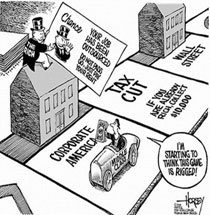Welcome to Monopoly
A Monopoly must be distinguished from monopsony, in which there is only one buyer of a product or service; a monopoly may also have monopsony control of a sector of a market. Likewise, a monopoly should be distinguished from a cartel (a form of oligopoly), in which several providers act together to coordinate services, prices or sale of goods. Monopolies, monophonies and oligopolies are all situations where one or a few of the entities have market power and therefore must interact with their customers (monopoly), suppliers (monopsony) and the other firms (oligopoly) in a game theoretic manner - meaning that expectations about their behavior affects other players' choice of strategy and vice versa. This is to be contrasted with the model of perfect competition where firms are price takers and do not have market power. Monopolists typically produce fewer goods and sell them at a higher price than under perfect competition, resulting in abnormal and sustained profit. (See also Bertrand, Cournot or Stackelberg equilibrium, market power, market share, market concentration, Monopoly profit, and industrial economics).
Monopolies can form naturally or through vertical or horizontal mergers. A monopoly is said to be coercive when the monopoly firm actively prohibits competitors from entering the field or punishes competitors who do.
In many jurisdictions, competition laws place specific restrictions on monopolies. Holding a dominant position or a monopoly in the market is not illegal in itself, however certain categories of behavior can, when a business is dominant, be considered abusive and therefore be met with legal sanctions. A government-granted monopoly or legal monopoly, by contrast, is sanctioned by the state, often to provide an incentive to invest in a risky venture or enrich a domestic interest group. Patents, copyright, and trademarks are all examples of government granted and enforced monopolies. The government may also reserve the venture for itself, thus forming a government monopoly.


